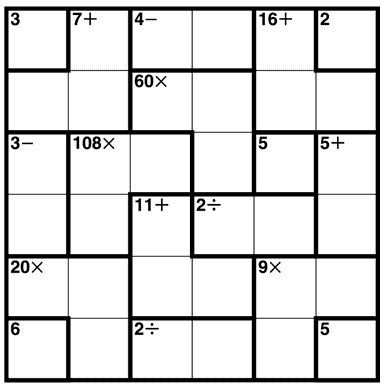A KenKen Cheat Sheet
December 18, 2009 3 Comments
If you don’t know what KenKen is, it is a ‘Sudoku like’ number game. The board looks as follows:
It is usually played on a 6-by-6 grid and with the numbers 1 to 6. Like in Sudoku each number must appear in each row and column exactly once.
The grid is furthermore split into ‘cells’. Each cell has a number and an operation attached to it. (1-by-1 cells do not have an operation attached to it for obvious reasons.)
The numbers in the cell must combine together, under the given operation, to make the specified number. So for example, the “5+” cell (on the most-right column) could be ‘1,4’ or ‘2,3’ (in any order).
The subtraction and division operators only ever appear in cells with two squares in it. The order does not matter so ‘2÷’ could be ‘4,2’, ‘6,3’ or ‘2,1’ in any order.
For cells which are not in a straight line it is possible to have a number repeated in it. For instance, ’11+’ (near the bottom) could be ‘5,5,1’, although there is only one possible way or arranging that so that no number appears on a row or column twice.
Obviously a key point in starting these games is knowing which cells have unique answers. I have therefore produced a list. I found them using my first ever Haskell program. (I learnt Haskell a bit ago but never used it for anything before today as I usually use Mathematica.) It is such a nice language to use. It covers all two-, three- and four-square cell types (although for four-square cells I merely listed the unique ones rather than giving their breakdown too).
The KenKen Uniqueness Guide (PDF)
For instance, in the example above you can straight away read that ‘108×’ and ‘9×’ both have unique solutions you can write down straight away (as they only have one configuration, too).
(Easy KenKen related exercise question: Show that 2×2 squares are equivalent to 4-square ‘snakes’ . That is, each configuration of one leads to a configuration of the other.)

i still dont get it, can you explain it on a (4 by 4) grid thank you
I have 6×6 due today for honors geometry, please can u give the answers to me, 268 and 269
I have a 7×7, an 8×8, and a 9×9 due tomorrow and it is hard mind if you could give me some answers. Page 17, 18, and 19.